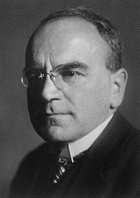|
Instituut voor Studie van Schimmel in Menselijke Woningen |
|
Institut pour l'Etude de Moisissure Fongique dans Habitations Humaines |
|
Forschung Institute für Schimmelpilze in Innenräumen |
|
MYCOLOGICAL INSTITUTE |
|
for the study of |
|
FUNGAL MOLD IN HUMAN HABITATIONS |
1953 Celebrating 50 Years of DNA 2003
Heinrich O. Wieland
|
|
|
| Download the Noble Prize Lecture *R. Gdansk |
1927 Nobel Prize in Chemistry
Heinrich O. Wieland – Biography
 Heinrich Otto
Wieland was born as the son of Württemberger parents, Dr. Theodor
Wieland and Elise Blom, on June 4, 1877, in Pforzheim where his father was
a pharmaceutical chemist. He studied at the Universities of Munich, Berlin and Stuttgart, and then returned to the Baeyer Laboratory in
Munich where, in 1901, he received his doctorate under Johannes Thiele. In
Munich, where he had chosen to make his home, he received in 1904 the
venia legendi and in 1913
a senior lectureship in the University Chemical Laboratory. In 1917 he
transferred his activities to the Technical College nearby as a full
Professor. From 1917-1918 he was busy at the Kaiser Wilhelm Institute in
Berlin-Dahlem working on Defence. In 1921 he accepted a call to Freiburg
and in 1925 returned to Munich at Willstätter's request to succeed him in his
Chair in the University of Munich. For twenty-seven years the destiny of
the Munich laboratory lay in his hands.
Heinrich Otto
Wieland was born as the son of Württemberger parents, Dr. Theodor
Wieland and Elise Blom, on June 4, 1877, in Pforzheim where his father was
a pharmaceutical chemist. He studied at the Universities of Munich, Berlin and Stuttgart, and then returned to the Baeyer Laboratory in
Munich where, in 1901, he received his doctorate under Johannes Thiele. In
Munich, where he had chosen to make his home, he received in 1904 the
venia legendi and in 1913
a senior lectureship in the University Chemical Laboratory. In 1917 he
transferred his activities to the Technical College nearby as a full
Professor. From 1917-1918 he was busy at the Kaiser Wilhelm Institute in
Berlin-Dahlem working on Defence. In 1921 he accepted a call to Freiburg
and in 1925 returned to Munich at Willstätter's request to succeed him in his
Chair in the University of Munich. For twenty-seven years the destiny of
the Munich laboratory lay in his hands.
Wieland's scientific work,
recorded in four hundred publications, covers a wide field in the realm of
Organic Chemistry and Biochemistry.
For several decades Wieland's
attention was claimed by the organic nitrogenous compounds. His brilliant
studies of the reaction of nitrogen oxides with orefins and aromatics, the
clarification of furoxanes as well as the classical experiments with
fulminic acid and its polymerization may be chosen as examples. In the
same connection, Wieland succeeded in the first production of stable
organic nitrogen radicals, of diphenyl nitrogen and its N-oxide. The proof
of short-lived radicals in solution reactions involved him in an extensive
series of experiments whose importance for the modern development of
organic radical chemistry can hardly be overestimated.
In later
years Wieland was entirely devoted to the chemistry of natural substances.
His contributions to the clarification of the structure of morphine and
strychnine, the constitution and synthesis of the lobelia alkaloid and the
research into the curare alkaloid were masterpieces. Work on the poisonous
agent in the "death cap" mushroom led to the isolation of the crystalline
cyclopeptides phalloidine and amanitine; work on the pigment of
butterflies led to the discovery of the biologically important class of
pterin compounds. The publications which began in 1912 on the subject of
bile acids culminated in 1932 in the clarification of the carbon framework
of the steroids, whose general importance in Nature Wieland
recognized.
Much of Wieland's life work was occupied by the
investigations into the oxidation processes in living cells, which enabled
him to recognize dehydrogenation as a universal oxidation principle in
Nature. This work restored the unity of Organic Chemistry and Biochemistry
which had been lost since the time of Liebig.
It is not
surprising that Wieland was accorded all the honours that the scientific
world has to offer. He was a member of the great learned societies of the
world, he was awarded a Nobel Prize in 1927, he received the Order of
Merit and the Otto Hahn Prize, and for
twenty years he was Editor of Justus Liebigs Annalen der Chemie.
Wieland's great school is evidence of his importance as an academic
teacher.
In an age of increasing specialization, Wieland was among
the last of those who were able to enjoy an encyclopaedic knowledge of the
whole of Chemistry.
In 1908, he married
Josephine Bartmann of Munich. They had three sons, Wolfgang, a doctor of
pharmaceutical chemistry; Theodor, professor of chemistry in the
University of Frankfurt; and Otto, professor of medicine in the University
of Munich, and one daughter, Eva, who is married to Professor Feodor
Lynen professor of
biochemistry in the University of Munich, Nobel Laureate in Physiology or
Medicine, 1964.
The great scholar's life was ruled by hard work,
but also by love and kindness both to his pupils and to his family; it
ended shortly after his 80th birthday, on August 5, 1957, in
Starnberg.
From Nobel Lectures, Chemistry 1922-1941, Elsevier Publishing Company, Amsterdam, 1966
This autobiography/biography was written at the time of the award and later published in the book series Les Prix Nobel/Nobel Lectures. The information is sometimes updated with an addendum submitted by the Laureate. To cite this document, always state the source as shown above.

